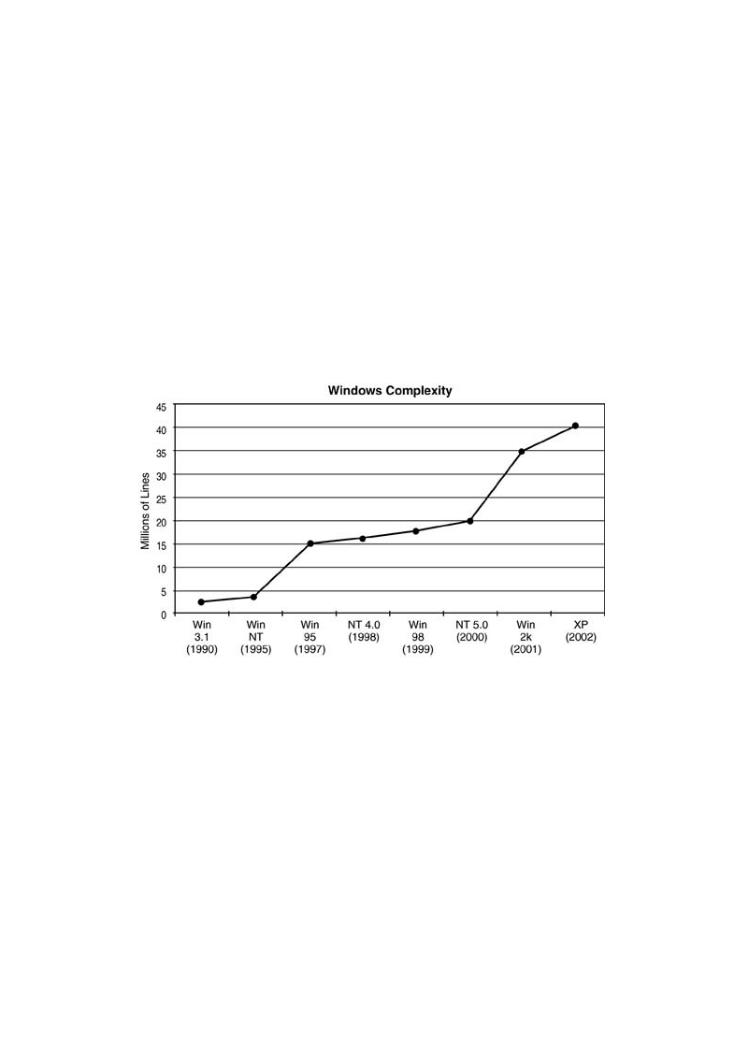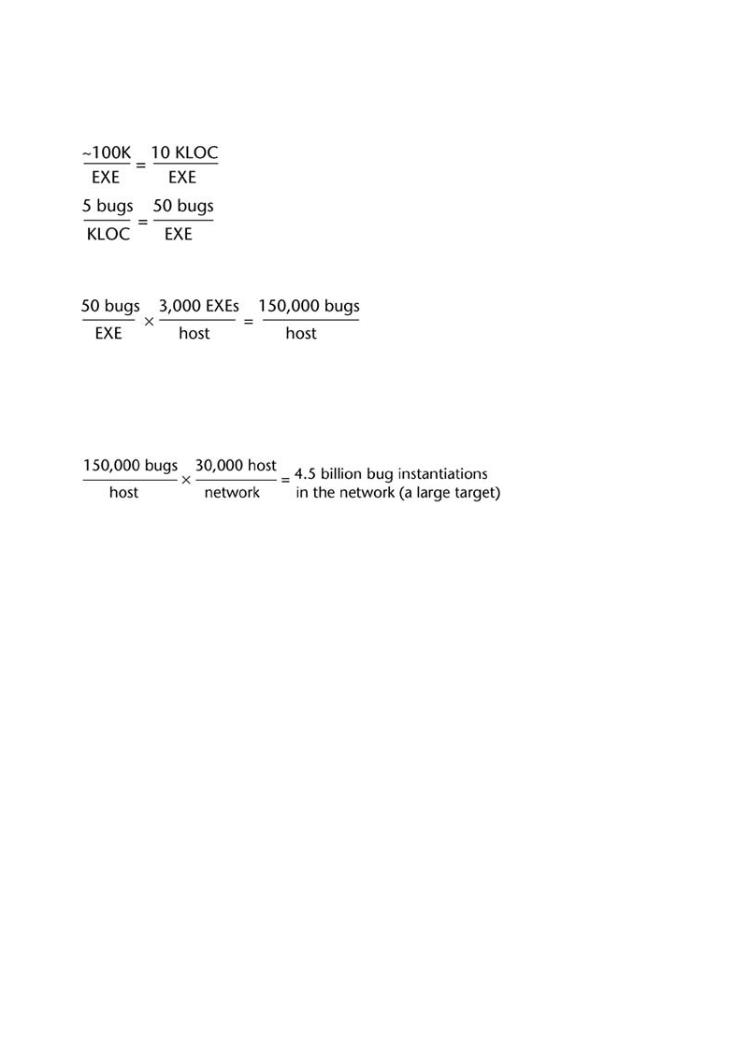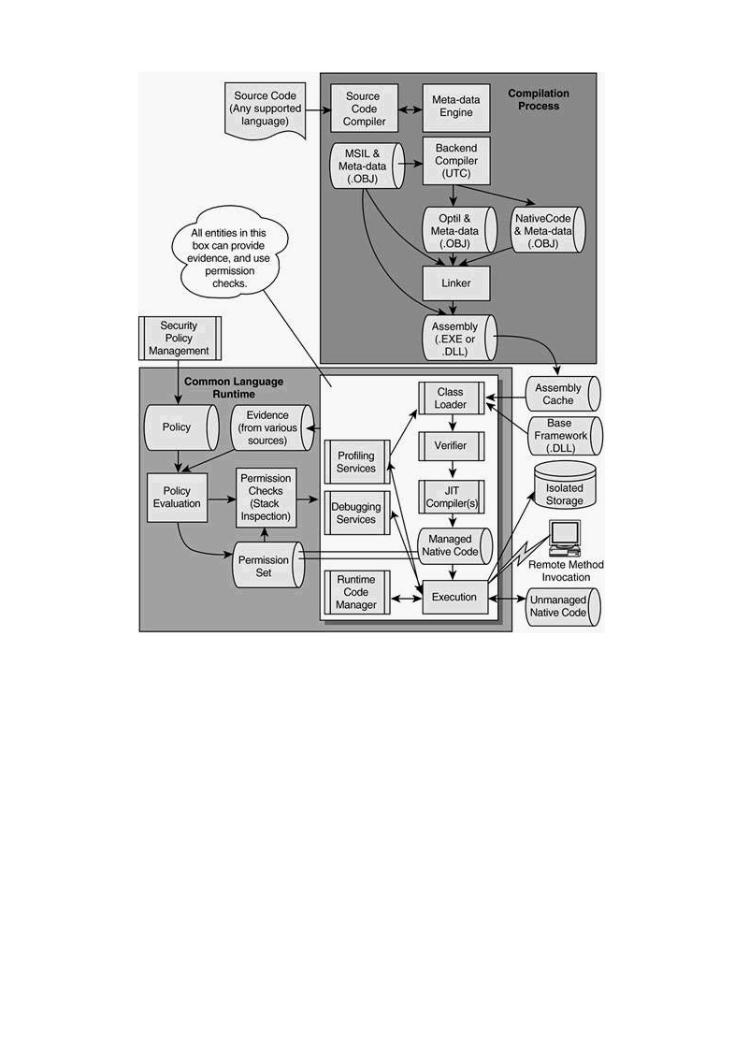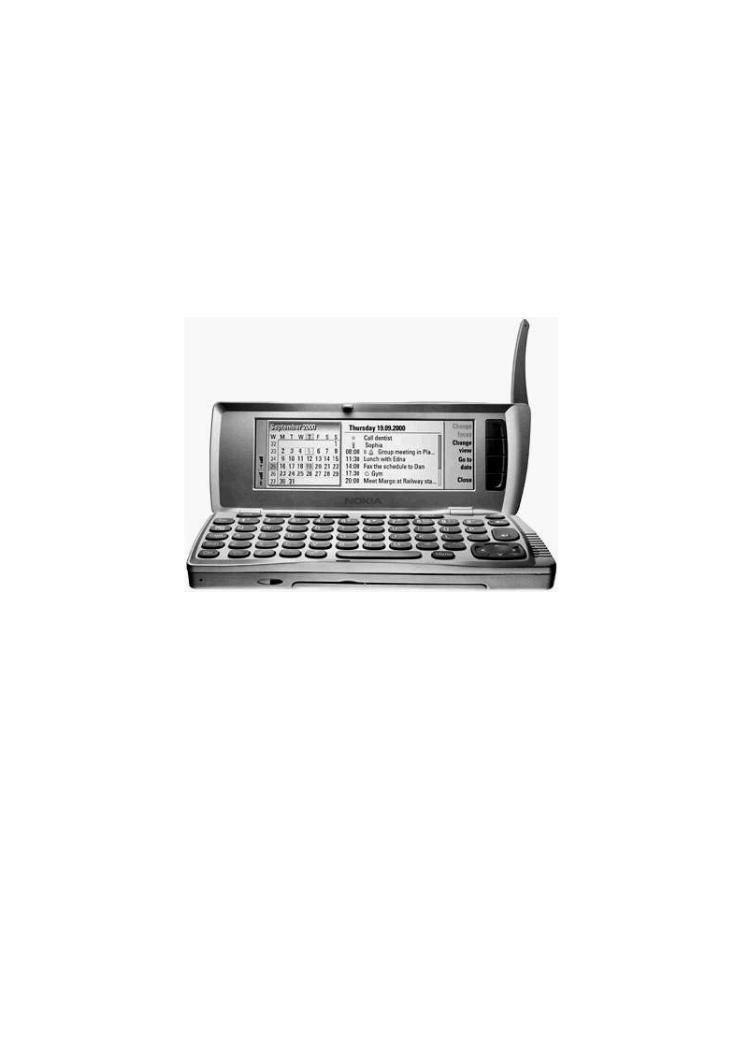
- •Exploiting Software How to Break Code
- •Table of Contents
- •Copyright
- •Praise for Exploiting Software
- •Attack Patterns
- •Foreword
- •Preface
- •What This Book Is About
- •How to Use This Book
- •But Isn't This Too Dangerous?
- •Acknowledgments
- •Greg's Acknowledgments
- •Gary's Acknowledgments
- •Bad Software Is Ubiquitous
- •The Trinity of Trouble
- •The Future of Software
- •What Is Software Security?
- •Conclusion
- •Chapter 2. Attack Patterns
- •A Taxonomy
- •An Open-Systems View
- •Tour of an Exploit
- •Attack Patterns: Blueprints for Disaster
- •An Example Exploit: Microsoft's Broken C++ Compiler
- •Applying Attack Patterns
- •Attack Pattern Boxes
- •Conclusion
- •Into the House of Logic
- •Should Reverse Engineering Be Illegal?
- •Reverse Engineering Tools and Concepts
- •Approaches to Reverse Engineering
- •Methods of the Reverser
- •Writing Interactive Disassembler (IDA) Plugins
- •Decompiling and Disassembling Software
- •Decompilation in Practice: Reversing helpctr.exe
- •Automatic, Bulk Auditing for Vulnerabilities
- •Writing Your Own Cracking Tools
- •Building a Basic Code Coverage Tool
- •Conclusion
- •Chapter 4. Exploiting Server Software
- •The Trusted Input Problem
- •The Privilege Escalation Problem
- •Finding Injection Points
- •Input Path Tracing
- •Exploiting Trust through Configuration
- •Specific Techniques and Attacks for Server Software
- •Conclusion
- •Chapter 5. Exploiting Client Software
- •Client-side Programs as Attack Targets
- •In-band Signals
- •Cross-site Scripting (XSS)
- •Client Scripts and Malicious Code
- •Content-Based Attacks
- •Conclusion
- •Chapter 6. Crafting (Malicious) Input
- •The Defender's Dilemma
- •Intrusion Detection (Not)
- •Partition Analysis
- •Tracing Code
- •Reversing Parser Code
- •Misclassification
- •Audit Poisoning
- •Conclusion
- •Chapter 7. Buffer Overflow
- •Buffer Overflow 101
- •Injection Vectors: Input Rides Again
- •Buffer Overflows and Embedded Systems
- •Database Buffer Overflows
- •Buffer Overflows and Java?!
- •Content-Based Buffer Overflow
- •Audit Truncation and Filters with Buffer Overflow
- •Causing Overflow with Environment Variables
- •The Multiple Operation Problem
- •Finding Potential Buffer Overflows
- •Stack Overflow
- •Arithmetic Errors in Memory Management
- •Format String Vulnerabilities
- •Heap Overflows
- •Buffer Overflows and C++
- •Payloads
- •Payloads on RISC Architectures
- •Multiplatform Payloads
- •Prolog/Epilog Code to Protect Functions
- •Conclusion
- •Chapter 8. Rootkits
- •Subversive Programs
- •A Simple Windows XP Kernel Rootkit
- •Call Hooking
- •Trojan Executable Redirection
- •Hiding Files and Directories
- •Patching Binary Code
- •The Hardware Virus
- •Low-Level Disk Access
- •Adding Network Support to a Driver
- •Interrupts
- •Key Logging
- •Advanced Rootkit Topics
- •Conclusion
- •References
- •Index

The Trinity of Trouble
Why is making software behave so hard? Three factors work together to make software risk management a major challenge today. We call these factors the trinity of trouble. They are
•Table of Contents
•Index
1. Complexity
Exploiting Software How to Break Code
ByGreg Hoglund,Gary McGraw
2. Extensibility
3.Publisher:ConnectivityAddison Wesley
Pub Date: February 17, 2004
ISBN: 0-201-78695-8
ComplexityPages: 512
Modern software is complicated, and trends suggest that it will become even more complicated in the near future. For example, in 1983 Microsoft Word had only 27,000 lines of code (LOC) but, according to Nathan Myhrvold,[8] by 1995 it was up to 2 million! Software engineersHow does softwarehave spentbreak?yearsHowtryingdotoattackersfigure outmakehowsoftwareto measurb eaksoftwareon purpose?. EntireWhybooksare devotedfirewalls,tointrusionsoftwaredetmetricsct onexistsy tems,. Ourandfavoriteantivirusone, softwareby Zuse [1991]not keeping, weighsoutintheat badmoreguys?than 800Whatpagestools.canYet beonlyusedonetometricbreakseemssoftware?to correlateThis bookwellprovideswith a numberthe answersof flaws:. LOC. In fact, LOC has become known in some hard-core software engineering circles as the only Exploitingreasonable metricSoftware. is loaded with examples of real attacks, attack patterns, tools, and techniques used by bad guys to break software. If you want to protect your software from
[8]Wired Magazine wrote a story on this issue that is available at
attack, you must first learn how real attacks are really carried out. http://www.wired.com/wired/archive/3.09/myhrvold.html?person=gordon_moore&topic_set=wiredpeople.
This must-have book may shock you—and it will certainly educate you.Getting beyond the
The number of bugs per thousand lines of code (KLOC) varies from system to system. script kiddie treatment found in many hacking books, you will learn about
Estimates are anywhere between 5 to 50 bugs per KLOC. Even a system that has undergone
rigorous quality assurance (QA) testing will still contain bugs—around five bugs per KLOC. A
software system that is only feature tested, like most commercial software, will have many Why software exploit will continue to be a serious problem
more bugs—around 50 per KLOC [Voas and McGraw, 1999]. Most software products fall into
the latterWhencatnetworkgory. Manysecuritysoftwaremechanismsvendorsdomistakenlynot work believe they perform rigorous QA
latterWhencatnetworkgory. Manysecuritysoftwaremechanismsvendorsdomistakenlynot work believe they perform rigorous QA
testing when in fact their methods are very superficial. A rigorous QA methodology goes well
beyondAttackunit pattestingernsand includes fault injection and failure analysis.
To giveReverseyou anengineeringidea of how much software lives within complex machinery, consider the
following:
 Classic attacks against server software
Classic attacks against server software
Surprising attacks against client software |
|
Lines of Code |
System |
Techniques for crafting malicious input |
|
400,000 |
Solaris 7 |
17 million |
Netscape |
The technical details of buffer overflows |
|
40 million |
Space Station |
Rootkits |
|
10 million |
Space Shuttle |
Exploiting Softwareis filled with the tools, concepts, and knowledge necessary to break
software7million. |
Boeing 777 |
35 million |
NT5 |
1.5 million |
Linux |
<5 million |
Windows 95 |
40 million |
Windows XP |

As we mention earlier, systems like these tend to have bug rates that vary between 5 and 50 bugs per KLOC.
One demonstration of the increase in complexity over the years is to consider the number of
LOC in various Microsoft operating systems. Figure 1-5 shows how the Microsoft Windows
operating system has grown since its inception in 1990 as Windows 3.1 (3 million LOC) to its
current form as Windows XP in 2002 (40 million LOC). One simple but unfortunate fact holds
true for software: more lines, more bugs. If this fact continues to hold, XP is certainly not |
|
• |
Table of Contents |
destined to be bug free![9] |
The obvious question to consider given our purposes is: How |
|
• |
Index |
|
many such problems will result in security issues? And how are bugs and other weaknesses
Exploiting Software How to Break Code
turned into exploits?
ByGreg Hoglund,Gary McGraw
[9] Nor has it turned out to be, with serious vulnerabilities discovered within months of its release.
Publisher: Addison Wesley
Pub Date: February 17, 2004
ISBN: 0-201-78695-8
Figure 1-5. Windows complexity as measured by LOC. Increased
Pages: 512
complexity leads to more bugs and flaws.
|
[View full size image] |
How does |
are |
firewalls, |
guys? |
What tools |
|
Exploiting |
and |
techniques |
from |
attack, |
|
This must |
the |
script kiddie |
|
Why |
|
When |
|
Attack |
|
Reverse engineering |
|
 Classic attacks against server software
Classic attacks against server software
A desktop system running Windows XP and associated applications depends on the proper
functioning of the kernel as well as the applications to ensure that an attacker cannot corrupt
 Surprising attacks against client software
Surprising attacks against client software
the system. However, XP itself consists of approximately 40 million LOC, and applications are
becoming equally (if not more) complex. When systems become this large, bugs cannot be Techniques for crafting malicious input
avoided.
 The technical details of buffer overflows
The technical details of buffer overflows
Exacerbating this problem is the widespread use of low-level programming languages such as
C or C++ that do not protect against simple kinds of attacks such as buffer overflows (which Rootkits
we discuss in this book). In addition to providing more avenues for attack through bugs and
Exploitingother desi nSoftwareflaws, complexis filledsyswitemsh themaketools,itconcepts,easier to andhideknowledgeor mask malineciousessarycodeto.breakIn theory,softwarewe. could analyze and prove that a small program is free of security problems, but this task is impossible for even the simplest desktop systems today, much less the enterprisewide systems used by businesses or governments.
More Lines, More Bugs
Consider a 30,000-node network, the kind that a medium-size corporation would probably have. Each workstation on the network contains software in the form of executables (EXE)

and libraries, and has, on average, about 3,000 executable modules. On average, each module is about 100K bytes in size. Assuming that a single LOC results in about 10 bytes of code, then at a very conservative rate of five bugs per KLOC, each executable module will have about 50 bugs:
Contents
Break Code
By |
, |
McGraw |
Now factor in the fact that each host has about 3,000 executables. This means that each
Publisher: Addison Wesley
machine in the network has about 150,000 unique bugs:
Pub Date: February 17, 2004
That's plenty of bugs to be sure, but the real trouble occurs when we consider possible targets and the number of copies of such bugs that exist as targets for attack. Because these same 150,000 bugs are copied many times over 30,000 hosts, the number of bug
How does software break? How do attackers make software break on purpose? Why are instantiations that an attacker can target is huge. A 30,000-machine network has about 4.5
firewalls, intrusion detectiton systems, and antivirus software not keeping out the bad guys? billion bug instantiations target (according to our estimate, only 150,000 of these bugs are
What tools can be used to break software? This book provides the answers. unique, but that's not the point):
patterns, tools, and your software from
This must-have book may shock you—and it will certainly educate you.Getting beyond the If we posit that 10% of all the bugs results in a security failure of some kind, and further
script kiddie treatment found in many hacking books, you will learn about
conjecture that only 10% of those bugs can be exercised remotely (over the network), then
according to our estimates, our toy network has 5 million remote software vulnerabilities to
attack. Resolving 150,000 bugs is a serious challenge, and properly managing the patches for
 Why software exploit will continue to be a serious problem
Why software exploit will continue to be a serious problem
5 million bug instantiations spread over 30,000 hosts is even worse:
 When network security mechanisms do not work
When network security mechanisms do not work
4.5 billion x 10% = 500 million security bug instantiations  Attack patterns
Attack patterns
500 million x 10% = 5 million remotely exploitable security bug targets  Reverse engineering
Reverse engineering
Clearly the attacker is on the winning side of these numbers. It is no surprise, given the
 Classic attacks against server software
Classic attacks against server software
homogeneity of operating systems and applications (leading to these skewed numbers), that
worms like the Blaster worm of 2003 are so successful at propagating.[10]  Surprising attacks against client software
Surprising attacks against client software
[10] Some security researchers conjecture that diversity might help address the problem, but experiments
Techniques for crafting malicious input
show that getting this idea to work in practice is more difficult than it appears at first blush.
 The technical details of buffer overflows
The technical details of buffer overflows
ExtensibilityRootkits
Exploiting Softwareis filled with the tools, concepts, and knowledge necessary to break Modern systems built around virtual machines (VMs) that preserve type safety and carry out
software.
runtime security access checks—in this way allowing untrusted mobile code to be executed—areextensible systems. Two prime examples are Java and .NET. An extensible host accepts updates or extensions, sometimes referred to as mobile code, so that the system's functionality can be evolved in an incremental fashion. For example, a Java Virtual Machine (JVM) will instantiate a class in a namespace and potentially allow other classes to interact with it.
Most modern operating systems (OSs) support extensibility through dynamically loadable device drivers and modules. Today's applications, such as word processors, e-mail clients,

spreadsheets, and Web browsers, support extensibility through scripting, controls, components, dynamically loadable libraries, and applets. But none of this is really new. In fact, if you think about it, software is really an extensibility vector for general-purpose computers. Software programs define the behavior of a computer, and extend it in interesting and novel ways.
Unfortunately, the very nature of modern, extensible systems makes security harder. For one thing, it is hard to prevent malicious code from slipping in as an unwanted extension,
•Table of Contents
meaning the features designed to add extensibility to a system (such as Java's class-loading
• Index
mechanism) must be designed with security in mind. Furthermore, analyzing the security of
Exploiting Software How to Break Code
an extensible system is much harder than analyzing a complete system that can't be changedByGreg Hoglund. How,GarycanMcGrawyou take a look at code that has yet to arrive? Better yet, how can you even begin to anticipate every kind of mobile code that may arrive? These and other security
issues surrounding mobile code are discussed at length in Securing Java [McGraw and Felten,
Publisher: Addison Wesley
1999].
Pub Date: February 17, 2004
ISBN: 0-201-78695-8
Microsoft has jumped headlong into the mobile code fray with their .NET framework. As
Pages: 512
Figure 1-6 shows, .NET architecture has much in common with Java. One major difference is a smaller emphasis on multiplatform support. But in any case, extensible systems are clearly here to stay. Soon, the term mobile code will be redundant, because all code will be mobile.
How does software break? How do attackers make software break on purpose? Why are
firewalls,Figureintr sion1detection-6. Thesystems,.NET frameworkand antivirus softwarearchitecturenot ke ping. Noticeut thethebad guys? Whatarchitecturaltools can be usimilarityed to b eak software?with theThisJavabookplatform:provides theverification,answers. just-in-
time (JIT) compilation, class loading, code signing, and a VM.
Exploiting Softwareis loaded with examples of real attacks, attack patterns, tools, and techniques used by bad guys to break software. If you want to protect your software from
attack, you must first learn how real attacks are really carried out.
[View full size image]
This must-have book may shock you—and it will certainly educate you.Getting beyond the script kiddie treatment found in many hacking books, you will learn about
 Why software exploit will continue to be a serious problem
Why software exploit will continue to be a serious problem
 When network security mechanisms do not work
When network security mechanisms do not work
 Attack patterns
Attack patterns
 Reverse engineering
Reverse engineering
 Classic attacks against server software
Classic attacks against server software
 Surprising attacks against client software
Surprising attacks against client software
 Techniques for crafting malicious input
Techniques for crafting malicious input
 The technical details of buffer overflows
The technical details of buffer overflows
 Rootkits
Rootkits
Exploiting Softwareis filled with the tools, concepts, and knowledge necessary to break
software.

•
•
Exploiting
ByGreg
Publisher
Pub Date
ISBN
Pages
How does |
are |
firewalls, |
guys? |
What tools |
|
Exploiting |
and |
techniques |
from |
attack, |
|
This must |
the |
script kiddie |
|
Why |
|
When |
|
Attack patterns |
|
 Reverse engineering
Reverse engineering
Mobile code has a dark side that goes beyond the risks inherent in its design for extensibility.
In some sense, viruses and worms are kinds of mobile code. That's why the addition of Classic attacks against server software
executable e-mail attachments and VMs that run code embedded on Web sites is a security
nightmareSurprising. Classicattacksvectorsagainstof theclientpast,softwareincluding the "sneakernet" and the infected executable
swapped over modems, have been replaced by e-mail and Web content. Mobile code-based
weaponsTechniquesare beingforusedcraftingby themaliciousmoderninputhacker underground. Attack viruses and attack
worms don't simply propagate, they install backdoors, monitor systems, and compromise
The technical details of buffer overflows machines for later use in nefarious purposes.
Rootkits
Viruses became very popular in the early 1990s and were mostly spread through infected
executable files shuffled around on disks. A worm is a special kind of virus that spreads over
Exploiting Softwareis filled with the tools, concepts, and knowledge necessary to break networks and does not rely on file infection. Worms are a very dangerous twist on the classic
software.
virus and are especially important given our modern reliance on networks. Worm activity became widespread in the late 1990s, although many dangerous worms were neither well publicized nor well understood. Since the early days, large advances have been made in worm technology. Worms allow an attacker to "carpet bomb" a network in an unbridled exploration that attempts to exploit a given vulnerability as widely as possible. This amplifies the overall effect of an attack and achieves results that could never be obtained by manually hacking one machine at a time. Because of the successes of worm technology in the late 1990s, most if not all global 1000 companies have been infected with backdoors. Rumors abound in the underground regarding the so-called Fortune 500 List—a list of currently

working backdoors to the Fortune 500 company networks.
One of the first stealthy, malicious worms to infect the global network and to be widely used as a hacking tool was written by a very secretive group in the hacker underground calling itselfADM, short for Association De Malfaiteurs. The worm, called ADMw0rm [11] exploits a buffer overflow vulnerability in domain name servers (DNS).[12] Once infected, the victim machine begins scanning for other vulnerable servers. Tens of thousands of machines were infected with this worm, but little mention of the worm ever made the press. Some of ADM's
•Table of Contents
original victims remain infected to this day. Alarmingly, the DNS vulnerability used by this
• Index
worm only scratched the surface. The worm itself was designed to allow other exploit
Exploiting Software How to Break Code
techniques to be added to its arsenal easily. The worm itself was, in fact, an extensible systemByGr g Hoglund. We can,GaryonlyMcGrawguess at how many versions of this worm are currently in use on the Internet today.
Publisher: Addison Wesley
[11] ADMw0rm-v1.tar can be found on various Internet sites and contains the source code to the infamous
Pub Date: February 17, 2004
ADM w0rm that first appeared in spring 1998.
ISBN: 0-201-78695-8
[12] More information on BIND problems can be found at http://www.cert.org/advisories/CA-
Pages: 512
98.05.bind_problems.html.
In 2001, a famous network worm called Code Red made headlines by infecting hundreds of thousands of servers. Code Red infects Microsoft IIS Web servers by exploiting a very simple and unfortunately pervasive software problem.[13] As is usually the case with a successful andHowhighlydoessoftwarepublicizedbreak?attack,Howseveraldo attackersvariationsmakeof thissoftwormarebreakhave beenonpurpose?seen in Whythewildare. Code Redfirewalls,infectsintrusiona serverdetecand tionhensystems,begins scanningand antiviforusadditionalsoftwaretargetsnot keeping.The originaloutthe versionbadguys?of CodeWhat Redtoolshascanabetendusencydtotobreakscansotherftware?machinesThis bookthatprovidesare in proximitythe answersto the. infected network. This limits the speed with which standard Code Red spreads.
Exploiting Softwareis loaded with examples of real attacks, attack patterns, tools, and
[13] Code Red exploits a buffer overflow in the idq.dll, a component of ISAPI.
techniques used by bad guys to break software. If you want to protect your software from
attack, you must first learn how real attacks are really carried out.
Promptly after its network debut, an improved version of Code Red was released that fixed
this problem and added an optimized scanning algorithm to the mix. This further increased This must-have book may shock you—and it will certainly educate you.Getting beyond the
the speed at which Code Red infects systems. The success of the Code Red worm rests on a script kiddie treatment found in many hacking books, you will learn about
very simple software flaw that has been widely exploited for more than 20 years. The fact that a large number of Windows-based machines share the flaw certainly helped Code Red spreadWhyas quicklysoftwareasexploitdid.will continue to be a serious problem
SimilarWheneffectsnetworkhave sbeencuritynotedmechafor newismsworms,do notincludingwork Blaster and Slammer. We will
further address the malicious code problem and its relation to exploiting software later in the
Attack patterns
book. We'll also take a look at hacking tools that exploit software.
 Reverse engineering
Reverse engineering
Connectivity
Classic attacks against server software
Surprising attacks against client software
The growing connectivity of computers through the Internet has increased both the number
of attack vectors (avenues for attack) and the ease with which an attack can be made.
Techniques for crafting malicious input
Connections range from home PCs to systems that control critical infrastructures (such as the
power grid). The high degree of connectivity makes it possible for small failures to propagate
 The technical details of buffer overflows
The technical details of buffer overflows
and cause massive outages. History has proved this with telephone network outages and
power system grid failures as discussed on the moderated COMP.RISKS mailing list and in
Rootkits
the book Computer-Related Risks [Neumann, 1995].
Exploiting Softwareis filled with the tools, concepts, and knowledge necessary to break
Because access through a network does not require human intervention, launching software.
automated attacks is relatively easy. Automated attacks change the threat landscape. Consider very early forms of hacking. In 1975, if you wanted to make free phone calls you needed a "blue box." The blue box could be purchased on a college campus, but you needed to find a dealer. Blue boxes also cost money. This meant that only a few people had blue boxes and the threat propagated slowly. Contrast that to today: If a vulnerability is uncovered that allows attackers to steal Pay-Per-View television, the information can be posted on a Web site and a million people can download the exploit in a matter of hours, deeply impacting profits immediately.

New protocols and delivery mediums are under constant development. The upshot of this is more code that hasn't been well tested. New devices are under development that can connect your refrigerator to the manufacturer. Your cellular phone has an embedded OS complete with a file system. Figure 1-7 shows a particularly advanced new phone. Imagine what would happen when a virus infects the cellular phone network.
•Table of Contents
Figure 1-7. This is a complex mobile phone offered by Nokia. As
• Index
phones gain functionality such as e-mail and Web browsing, they
Exploiting Software How to Break Code
become more susceptible to software exploit.
ByGreg Hoglund,Gary McGraw
Publisher: Addison Wesley
Courtesy of Nokia.
Pub Date: February 17, 2004
ISBN: 0-201-78695-8
Pages: 512
How does software |
Why are |
firewalls, intrusion |
the bad guys? |
What tools can be |
|
Exploiting Software |
tools, and |
techniques used |
software from |
attack, you must |
|
This must-have |
beyond the |
script kiddie |
|
Why software |
|
When network security mechanisms do not work |
|
 Attack patterns
Attack patterns
Highly connected networks are especially vulnerable to service outages in the face of network
worms. One paradox of networking is that high connectivity is a classic mechanism for Reverse engineering
increasing availability and reliability, but path diversity also leads to a direct increase in wormClasssurvicvabilityattacks. against server software
Finally,Surprisingthe mostattacksimportantgainstaspectclientof thesoftwareglobal network is economic. Every economy on earth is connected to every other. Billions of dollars flow through this network every second, trillionsTechniquesof dollarsforevecryaftingday.maliciousThe SWIFTinputnetwork alone, which connects 7,000 international
financial companies, moves trillions of dollars every day. Within this interconnected system,
The technical details of buffer overflows
huge numbers of software systems connect to one another and communicate in a massive
stream of numbers. Nations and multinational corporations are dependent on this modern
Rootkits
information fabric. A glitch in this system could produce instant catastrophe, destabilizing
entire economies in seconds. A cascading failure could well bring the entire virtual world to a
Exploiting Softwareis filled with the tools, concepts, and knowledge necessary to break grinding halt. Arguably, one target of the despicable act of terrorism on September 11, 2001,
software.
was to disrupt the world financial system. This is a modern risk that we must face.
The public may never know how many software attacks are leveraged against the financial system every day. Banks are very good about keeping this information secret. Given that network-enabled computers have been confiscated from many convicted criminals and known terrorists, it would not be surprising to learn that criminal and terrorist activity includes attacks on financial networks.

The Upshot
Taken together, the trinity of trouble has a deep impact on software security. The three trends of growing system complexity, built-in extensibility, and ubiquitous networking (or connectivity) make the software security problem more urgent than ever. Unfortunately for the good guys, the trinity of trouble has a tendency to make exploiting software much easier!
•In March 2003,Tabletheof ContentsComputer Security Institute released its eighth annual survey showing that• 56% of Indthex524 companies and large institutions polled acknowledged suffering financial lossesExploitingresultingSof warefromHow computerto Break Codebreaches during the previous year. The majority of these
breaches were carried out over the Internet. Of the compromised targets, the 251 willing to
ByGreg Hoglund,Gary McGraw
tally their losses admitted that the hacking cost them roughly $202 million collectively. Even
if these numbers are off by a factor of ten, they are still unacceptably high. Although the
Publisher: Addison Wesley
particular numbers reported in this highly popular survey can be disputed, trends emerging
Pub Date: February 17, 2004
from the annual completion of this survey are an excellent indicator of the growth and
ISBN: 0-201-78695-8
importance of the computer security problem.
Pages: 512
How does software break? How do attackers make software break on purpose? Why are firewalls, intrusion detection systems, and antivirus software not keeping out the bad guys? What tools can be used to break software? This book provides the answers.
Exploiting Softwareis loaded with examples of real attacks, attack patterns, tools, and techniques used by bad guys to break software. If you want to protect your software from attack, you must first learn how real attacks are really carried out.
This must-have book may shock you—and it will certainly educate you.Getting beyond the script kiddie treatment found in many hacking books, you will learn about
 Why software exploit will continue to be a serious problem
Why software exploit will continue to be a serious problem
 When network security mechanisms do not work
When network security mechanisms do not work
 Attack patterns
Attack patterns
 Reverse engineering
Reverse engineering
 Classic attacks against server software
Classic attacks against server software
 Surprising attacks against client software
Surprising attacks against client software
 Techniques for crafting malicious input
Techniques for crafting malicious input
 The technical details of buffer overflows
The technical details of buffer overflows
 Rootkits
Rootkits
Exploiting Softwareis filled with the tools, concepts, and knowledge necessary to break
software.
